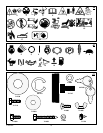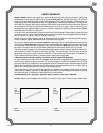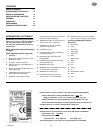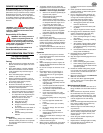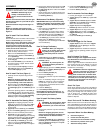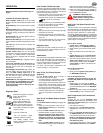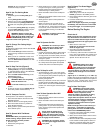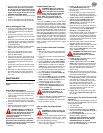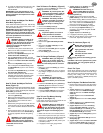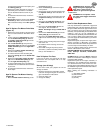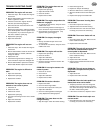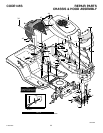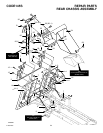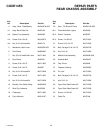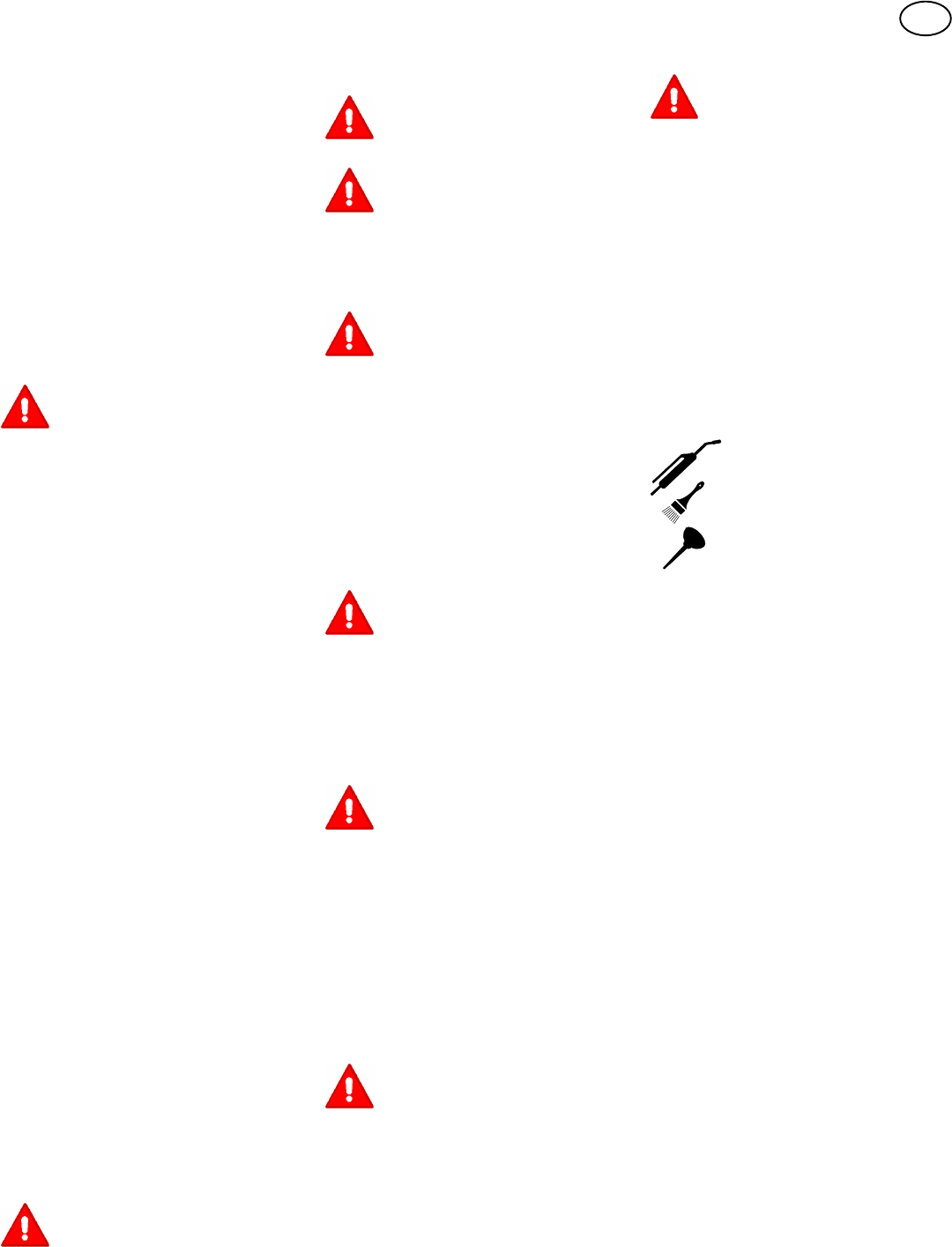
GB
18
F–000794J
6. To check the adjustment, drive the unit. If the
adjustment is correct, the unit will now go
into REVERSE.
IMPORTANT: If you need assistance, go to
the nearest Authorized Service Centre. They
have the equipment and experience to make
the adjustment.
How To Check And Adjust The Motion
Drive Belt
(Figure 24)
If the motion drive belt is loose, the belt will slip
when; going up a hill, pulling a heavy load, or the
unit will not move forward.
IMPORTANT: Always operate with the engine
speed in the FAST position. If the engine
speed is in a slow or moderate position, the
engine and transmission can become too hot
and cause problems that are similar to a
loose motion drive belt.
WARNING: Before you make an in-
spection, adjustment, or repair to
the unit, disconnect the wire to the
spark plug. Remove the wire from the
spark plug to prevent the engine from
starting by accident.
1. Check the routing of the motion drive belt.
Make sure the belt is installed correctly and
is inside all the belt guides.
2. Disconnect the adjustable nut (1) from the
motion drive idler assembly (2).
3. Pull the clutch rod (3) until tight. Turn the
adjustable nut (1) until the nut will fit through
the hole in the motion drive idler assembly
(2).
4. Remove the adjustable nut (1) from the
hole. To lengthen the clutch rod (3), rotate
the adjustable nut (1) 3 to 4 turns counter–
clockwise.
5. Assemble the adjustable nut (1) to the mo-
tion drive idler assembly (2).
6. If the belt still slips after the belt has been
adjusted, then the motion drive belt is worn
or damaged and must be replaced. See
“How To Replace The Motion Drive Belt”.
How To Check And Adjust The Drive
Brake
(Figure 15)
Completely push the brake pedal forward. Set the
parking brake. Push the unit. If the rear wheels
rotate, adjust or replace the brake pads. Adjust the
drive brake (1) as follows.
1. The location of the drive brake (1) is on the
side of the gearbox (3).
2. Make sure the parking brake is set. Turn the
hex nut (2) in a clockwise direction until the
rear wheels do not turn when the unit is
pushed forward.
3. Release the parking brake and push the unit.
If the unit does not roll, turn the hex nut (2)
in a counter–clockwise direction until the unit
rolls.
4. Set the parking brake. Push the unit. If the
rear wheels do not turn, the drive brake (1)
is correctly adjusted. Release the parking
brake.
WARNING: If you cannot correctly
adjust the drive brake, replace the
brake pads. Correct replacement
parts and assistance are available from an
authorized service centre.
How To Remove The Battery
(Figure 6
)
To charge or clean the battery (1), remove the
battery (1) from the unit as follows.
WARNING: To prevent sparks, dis-
connect the black battery cable (8)
from the negative (–) terminal be-
fore you disconnect the red cable (5).
WARNING: The battery contains
sulphuric acid which is harmful to
the skin, eyes and clothing. If the
acid gets on the body or clothing, wash
with water.
1. Remove the battery cover (3).
2. Remove the fasteners (9) from the battery
brackets (10,11).
To prevent sparks, do not touch
battery brackets to terminals.
3. Apply pressure to the left hand battery
bracket (10) and remove bracket from frame
(12) as shown.
4. Remove the right hand battery bracket
(11).
5. Disconnect the black cable (8) from the
negative (–) terminal.
6. Disconnect the red cable (5) from the posi-
tive (+) terminal (4).
7. Lift the battery (1) out of the unit.
How To Charge The Battery
(Figure 6)
WARNING: When you charge the
battery, do not smoke. Keep the
battery away from any sparks. The
fumes from the battery acid can cause an
explosion.
1. Before you charge the battery (1), remove
the battery (1).
2. To charge the battery (1), use a 12 volt bat-
tery charger. Charge at a rate of 6 amperes
for 1 hour.
3. Install the battery (1).
WARNING: To prevent sparks,
fasten the red cable to the positive
(+) terminal before you connect the
black cable.
4. Fasten the red cable (5) to the positive (+)
terminal (4) with the fasteners as shown.
Slide the terminal cover (2) over the posi-
tive terminal (4).
5. Fasten the black cable (8) to the negative
(–) terminal with the fasteners as shown.
How To Level The Mower Housing
(Figure 16 and Figure 17)
If the mower housing is level, the blade will cut
easier and the lawn will look better.
WARNING: Before you make an in-
spection, adjustment, or repair to
the unit, disconnect the wire to the
spark plug. Remove the spark plug wire to
prevent the engine from starting by acci-
dent
1. Make sure the unit is on a hard flat surface.
2. Check the air pressure in the tyres. If the air
pressure is incorrect, the mower housing will
not cut level. The correct air pressure is:
Front Tyres 1,38 BAR (20 PSI), Rear Tyres
0,97 BAR (14 PSI).
3. If equipped, remove the gauge wheels.
4.
(Figure 16)
Move the lift lever (1) to the
level adjustment position (2).
WARNING: The lifter lever (1) is
spring loaded. Make sure the lift
lever (1) is locked in the level ad-
justment position (2).
5.
(Figure 17)
Loosen the left and right ad-
juster knobs (1). Push down on each side of
the mower housing. Make sure both sides of
the mower housing are setting on a flat sur-
face. Also, make sure the lift links (2) are
loose and can easily move up or down
6. Push down on the lift links (2) and tighten
the left and right adjuster knobs (1). If
necessary, use a wrench to tighten the ad-
juster knobs (1)
7.
(Figure 16)
Raise the lift lever (1).
8. If equipped, attach the gauge wheels.
9. Mow for a short distance. If the height of cut
is not level, repeat the above steps.
Where To Lubricate
(Figure 14)
Lubricate the areas shown
with engine oil.
Apply grease with a brush to
the areas shown.
Models with grease fittings:
Lubricate with grease gun.
NOTE: Apply grease to the steering gear as-
sembly.
CAUTION: If the unit is operated in dry areas
that have sand, use a dry graphite spray to
lubricate the unit.
Check The Tyres
Check the air pressure in the tyres. Tyres with too
much air pressure will cause the unit to ride rough.
Also, the wrong air pressure will keep the mower
housing from cutting level. The correct air
pressure is: Front Tyres 1,38 BAR (20 PSI), Rear
Tyres 0,97 BAR (14 PSI).
How To Replace The Motion Drive Belt
1. Remove the mower housing. See the instruc-
tions on “How To Remove The Mower Hous-
ing”.
2.
(Figure 19)
Remove the screws (1), that
hold each side of the middle discharge
chute (2). Remove the middle discharge
chute (2)..
3.
(Figure 18)
Disconnect the belt tension
spring (1).
4.
(Figure 23)
Remove the three idler pulleys
(2).
5.
(Figure 18)
Remove the adjuster nut (3)
from the idler bracket (4).
6.
(Figure 20)
Remove the three screws (1)
from the transaxle sheild (2). Place the
transaxle shield (2) in the tunnel (3). The
bag full indicator (4) wire harness will limit
the transaxle sheild (2) movement.
7.
(Figure 21)
Loosen the belt guide (1) at the
drive pulley (3).
8. Remove the motion drive belt (4) from the
drive pulley (3).
9.
(Figure 22)
To remove the motion drive belt
(1) from the stack pulley (2), pull the front
end of the belt under the stack pulley (2)



